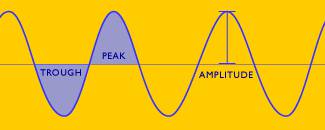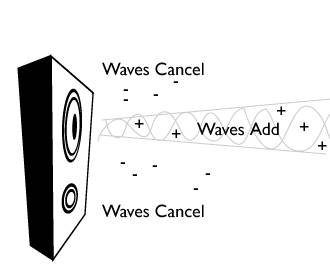A collection of recently developed audio technologies allows for the creation of thin, directional sound beams. With this type of equipment, focused streams of sound can be pointed exactly where the user wants them. Directional sound technology will likely see widespread adoption in the near future as engineers continue developing sound beam technology for numerous applications including acoustic weaponry, richer sound effects for the entertainment industry, as well as more commercial uses.
Introduction
Imagine you could point sound the same way you can point light with, say, a flashlight. Suppose speakers existed that could send focused beams of sound wherever they were pointed. You could speak into a megaphone and send the sound to a single person. Or you could have five types of music playing on the same dance floor. You wouldn’t have to worry about turning your music down at night to keep the neighbors happy, so long as you didn’t point it in their direction.
Thanks to recent advancements in audio engineering, this kind of product may soon be a reality. Researchers have discovered a way to project acoustic waves as a thin beam of sound: step into the beam, and the projected sound fills your ears; step out again, and you hear nothing. This new technology has sparked the interest of everyone from the U.S. Military to U2’s Bono [1]. In the next few pages, we will see how directional sound technology works and explore how it might be used in the near future.
How it Works
Sounds are waves of pressure variations moving through the air. These waves can be compared to waves moving in the ocean, although they move much more quickly and in three dimensions, unlike water waves, which are confined to a two-dimensional surface. When we hear sounds, what we are actually experiencing are minute vibrations of air. As waves of these small air currents pass through our inner ears, they stimulate the nerves in tiny hair-like projections. Our brain then translates this stimulation into the audible sound that we hear.
When a sound wave is generated, it travels away from its source in a beam, in similar fashion to a beam of light emanating from a flashlight. However, the normal angular size, or width, of a typical sound beam is so large that it seems as though the sound travels away from the source in all directions as shown (see Fig. 1). This is because the angular size of a beam is determined by the ratio of its wavelength to the size of the opening through which the beam is projected [2]. If you wanted to transmit an average sound as a thin beam, you would need a speaker the size of a small building [2]. Since this is clearly impractical, a better option would be to decrease the wavelength of the beam.
The smallest wavelengths of audible sound are around 20 centimeters. However, new audio beam technology employs wavelengths on the order of a few millimeters. A simple depiction of a wave can be seen in Fig. 2. These waves are called ultrasonic, since they have frequencies above 20,000 Hz and are thus above the range of audible sound. When transmitted at high power levels, these ultrasonic waves change shape and interact with each other in air to produce lower frequency waves that are audible [3]. This interaction is known as intermodulation.
Intermodulation is a phenomenon that occurs when waves “mix” with each other to form new waves with different characteristics. As two high power sound waves travel through air they will distort and recombine to form two new waves at separate frequencies. One of the new waves occurs at the sum of the two original frequencies (sum frequency); the other occurs at the difference between the original frequencies (difference frequency) [4]. For example: if a 100 kHz wave and a 102 kHz wave were transmitted, their sum frequency would be 202 kHz and their difference frequency would be 2 kHz. The transmitted waves can be chosen such that their difference frequency is audible. The original wave frequencies and the sum frequency do not affect the listener since they are well above the audible range.
By controlling the frequencies of the two ultrasonic waves, any audible frequency can be produced. When multiple ultrasonic waves are transmitted at once, they combine into a complex waveform that can be manipulated to produce a broad range of sounds. If chosen carefully, these sound sources can be made to combine so that they cancel each other out as they move sideways, but add together as they move forward [3]. No sound is heard outside this beam (see Fig. 3).
The interaction of ultrasonic waves is fairly complex; however, engineers have designed signal processors that automatically choose the ultrasonic waves needed in order to produce the desired audio frequencies. Once the ultrasonic waves are chosen, electrical signals representing these waves can be constructed. These signals pass from the signal processor through an amplifier which increases their power level; the amplified signals then go on to an array of transducers, which convert the electrical energy into ultrasonic waves [5].
The Current State of Sound Beam Technology
Several companies are currently developing sound beam technology. The sound beam projectors they have designed are all fairly similar; they differ primarily in the algorithms they use to produce the waveforms and in the types of transducers they use. Their systems can project a 3 degree wide beam for distance of up to 150 yards without incurring any distortion or loss of volume [6].
Current sound beam projectors run into trouble, however, when they try to transmit sounds at lower frequencies. They cannot accurately reproduce sounds like the deeper notes on a bass guitar or the thump of a large bass drum. During one demonstration of the technology, some listeners complained that the sound quality was comparable to that of a small AM transistor radio [4]. This lack of performance is primarily due to limitations of current transducer technology, which does not allow for transmission over a broad enough range of frequencies [2]. Significant research efforts are underway to develop transducers with wider frequency range outputs, however. Once this limitation is overcome, sound reproduction should be at least as good, if not better, than normal speakers.
Once these problems are solved, sound beam models should soon be available to the general public. The units are estimated to cost between $600 and $900 depending on their size [7]. There are also a number of companies that have begun purchasing sound beam technology for use in upcoming applications [8].
Applications
Military
The military believes that sound beam technology may serve as an effective non-lethal acoustic weapon. Such a weapon could project sound along a narrow beam at intensities of 145 decibels, or 50 times the human threshold of pain [9]. To put this into perspective, the sound of an airplane taking off is about 140 decibels; 145 decibels is more than 3 times as loud. In the past, this type of weapon would have been impossible, as the sound would have affected not only the weapon’s operator, but also any innocent bystanders. This is not a problem, however, if the sound is directional.
The U.S. Army has already ordered a prototype of this new acoustic weapon. They intend to package it in a camouflage cylinder and use it either as a hand held weapon or mounted on the top of a vehicle [9]. This type of weapon might work well to repel suicide bombers or coerce terrorists from their hideouts. It would be especially useful in smaller, enclosed areas, such as caves in Afghanistan, since the sound would ricochet and penetrate deep inside [9].
The technology could also be used to confuse enemies in combat situations. Recorded sounds of gunfire or tank explosions could be made to sound as if they were coming from another area to confuse the enemy [7]. Conversations could be projected so as to sound as if there were American troops within enemy ranks. Opposing forces wouldn’t know which sounds to believe.
Entertainment
Once sound beam technology becomes widespread there will be many exciting new applications in the entertainment industry (see Fig. 4). Many different musicians are interested in the possibilities that this technology presents. U2’s Bono recently flew researchers from a leading developer of sound beam technology to Los Angeles to measure the acoustics during a Staples Center performance [1], so that they could investigate the technology’s feasibility in concert settings. A talented musician could put on quite a show if he were able to direct each individual instrument wherever he wanted.
Sound effects in movie theaters would be also much richer with sound beam technology. As an actor walks across the screen, sound beams could move with him and change direction along with the camera’s perspective [6]. As an airplane flies overhead, sound beams mounted in the ceiling could sweep over the audience, producing an extremely realistic effect.
With sound beam technology a dance club could play several styles of music on the same dance floor [8]. While one group of people were dancing to techno music, another could be listening to salsa. Off the dance floor it would be possible to have a conversation without having to scream above the blaring music.
If sound beams were installed in vehicles, there would never be another fight over the car’s radio tuner again. Each passenger could listen to his or her own music without disturbing anyone else in the car. The kids in the back could listen to heavy metal, while the adults listened to oldies up front [1]. While the driver listened to talk radio, the passengers could have a conversation.
These are just a few of the virtually limitless number of potential applications. Within the next 3 to 5 years sound beam technology should begin to find its way into many different areas of our everyday lives. We should also begin to see many new applications in a number of different areas. Just imagine the way that advertisers might use this type of technology. Don’t be surprised the next time you go to the supermarket and the donuts are pleading with you to buy them and eat them. Don’t worry, you aren’t crazy. The voices in your head are real.








